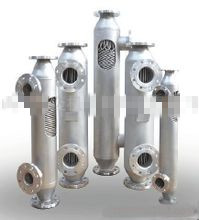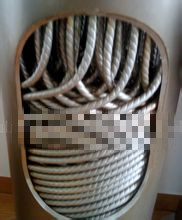1、Concept of spiral tube wound heat exchanger
The spiral tube wound heat exchanger is a new type of shell-and-tube heat exchanger, which is named spiral tube wound heat exchanger because the heat exchange tube is a structure formed by the reverse winding of the spiral tube, compared with the shell-and-tube heat exchangers and plate heat exchangers commonly used in China, it has a higher heat transfer efficiency, and has been widely used in pharmaceutical, fine chemicals, food and beverage, HVAC and other fields.

2、The advantages of spiral tube wound heat exchanger
1)、 Compared with the traditional tubular heat exchangers, each heat exchange tube bundle is coiled uniformly in the shell with a helical structure according to a certain rule. On the one hand, the length of the tube side is extended, and the heat transfer is fully realized, on the other hand, the fluid state in the shell side is changed greatly, which makes the fluid flow in a strong turbulent state, enhances the heat transfer and greatly improves the heat transfer coefficient. At the same time, the design of spiral winding elastic tube bundle can effectively eliminate pipe vibration and the stress caused by thermal expansion and cold contraction deformation.

2)、The spiral thread structure, the unique surface treatment technology and the countercurrent heat transfer of the two sides of the medium achieve the characteristics of high flow rate, low temperature gradient, low fouling coefficient, low scaling tendency.
3)、The volume of the heat exchanger is only about 1/10 of the volume of the general domestic shell-and-tube heat exchanger, which saves space, and is easy to install, disassemble and clean because of its small volume and light weight, reduce the cost of installation and maintenance; can not install the foundation, directly with the pipe connection.
4)、The heat transfer coefficient reflects whether the performance of the heat exchanger is superior or not. The maximum heat transfer coefficient can reach 14000 w/m2 · ° C under certain operating conditions.
5)、 The maximum temperature resistance is 400 ° C and the pressure resistance is 1.6 mpa. Because the heat exchange tube bundle and shell of the heat exchanger are made of stainless steel, it has a uniform expansion coefficient and will not cause the heat exchanger deformation because of the unstable pressure and temperature Heat exchangers are resistant to high temperature and pressure, and do not need temperature and pressure reduction devices.
6)、In the structure design, the resonance problem is fully considered, the acoustic standing wave vibration phenomenon is restrained effectively, and the running noise is limited to the maximum.